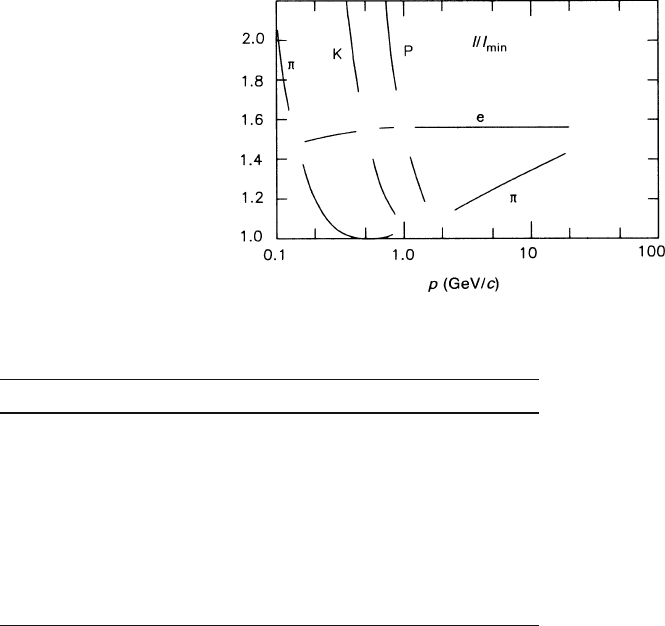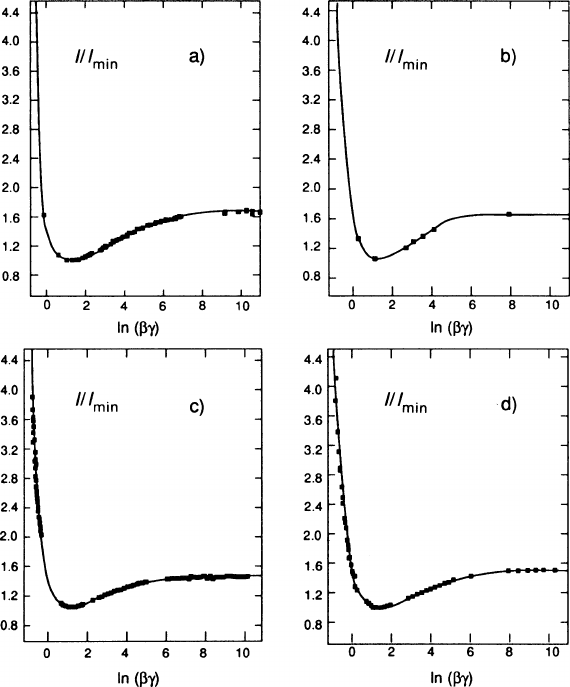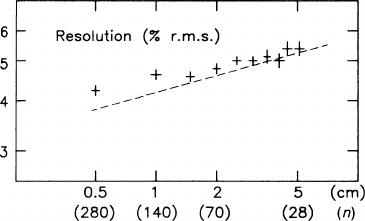Blum W., Riegler W., Rolandi L. Particle Detection with Drift Chambers
Подождите немного. Документ загружается.


Chapter 10
Particle Identification by Measurement
of Ionization
Among the track parameters, the ionization plays a special role because it is a
function of the particle velocity, which can therefore be indirectly determined
through a measurement of the amount of ionization along a track. For relativistic
particles this dependence is not very strong, and therefore the amount of ionization
must be measured accurately in order to be useful. The ionization has a very broad
distribution, and a track has to be measured on many segments (several tens to a few
hundred) in order to reach the accuracy required. Fortunately only relative values of
the ionization need to be known between tracks of different velocities.
Whereas in Chap. 1 we dealt with the ionization phenomenon in general terms,
the present chapter is devoted to a discussion of those aspects of ionization that
are important for particle identification. After an explanation of the principle we
elaborate on the factors that determine the shape of the ionization curve, and the
achievable accuracy. Calculated and measured particle separation powers are dis-
cussed next. One section is devoted to cluster counting. Finally, the problems
encountered in practical devices are reviewed.
10.1 Principles
In a magnetic spectrometer one measures the particle momentum through the curva-
ture of its track in the magnetic field. If a measurement of ionization is performed on
this track, there is the possibility of determining the particle mass, thus identifying
the particle. The relation between momentum p and velocity v involves the mass m:
v = c
2
p/E = c
2
p/
√
(p
2
c
2
+ m
2
c
4
), (10.1)
where c is the velocity of light.
Any quantification of ionization involves the peculiar statistics of the ionization
process. Let us recapitulate from Chap. 1 that the distribution function of the number
of electrons produced on a given track length has such a tail towards large numbers
that neither a proper mean nor a proper variance exists for the number of electrons.
W. Blum et al., Particle Detection with Drift Chambers, 331
doi: 10.1007/978-3-540-76684-1
10,
c
Springer-Verlag Berlin Heidelberg 2008
332 10 Particle Identification by Measurement of Ionization
In order to characterize the distribution one may quote its most probable value and
its width at half-maximum. The most probable number of electrons may be taken to
represent the ‘strength’ of the ionization. It is not proportional to the length of the
track segment. (We have seen in Figs. 1.10 and 1.11 how the most probable value of
the ionization per unit length goes up with the gas sample length.) From a number of
pulse-height measurements on one track one derives some measure I of the strength
of the ionization; details are given in Sect. 10.3. Since I depends on the velocity of
the particle and is proportional to the square of the charge Ze of the particle, we
write
I = Z
2
F
g,m
(v). (10.2)
F
g,m
(v) depends, firstly, on the nature of the gas mixture and its density (index g).
But it depends also on the length and number of samples and on the exact way in
which the ionization of the track is calculated from the ionization of the different
samples (index m); in addition, there is the small dependence of the relativistic rise
on the sample size. If we divide F
g,m
(v) by its minimal value (at v
min
), we obtain a
normalized curve
F
(norm)
g,m
(v)=F
g,m
(v)/F
g,m
(v
min
). (10.3)
It turns out that this curve is approximately independent of the exact manner of the
ionization measurement:
F
(norm)
g,m
(v) ≈ F
g
(v). (10.4)
(Some qualifications are mentioned in the end of Sect. 10.8.1) Most analyses of
the ionization loss have been done with this approximation, i.e. one neglects any
variation of the relativistic rise on the sample size and works with one universal
normalized curve.
Figure 1.19 contained theoretical values for the most probable ionization in
argon, as well as experimental values of the truncated mean in argon–methane
mixtures. The abscissa is the logarithm of
βγ
(
β
= v/c,
γ
2
= 1/(1 −
β
2
)), and the
vertical scale is normalized to the value in the minimum.
One cannot resolve (10.1), (10.2) and (10.4) into a form m = m(I, p) because
F
g
(v) is not monotonic. Therefore we discuss particle identification by plotting
F
g
(v) for various known charged particles as a function of p. Using the argon curve
of Fig. 1.19 we obtain the family of curves shown in Fig. 10.1. We see five curves of
identical shape, for electrons, muons, pions, kaons, and protons; they are displaced
with respect to each other on the logarithmic scale by the logarithms of the particle
mass ratios.
The simultaneous measurement of the momentum and the ionization of a particle
results in a point in the diagram of Fig. 10.1. Complete particle identification takes
place if, inside the measurement errors, this point can be associated with only one
curve. In practice the measurement errors of the ionization are very often so large
that several particles could have caused the measured ionization; if this is the case it
may be possible to exclude one or more particles.
For good particle identification the measurement accuracy
δ
I is obviously as
essential as the vertical distance between the curves in Fig. 10.1. It is therefore our
first task to review the gas conditions responsible for the shape of the curve and

10.1 Principles 333
Fig. 10.1 Most probable values of the ionization (normalized to the minimum value) in argon at
ordinary density as function of the momenta of the known stable charged particles
in particular for the amount of the relativistic rise. Then we have to understand the
circumstances that have an influence on
δ
I, and which value of
δ
I can be reached
in a given apparatus. The ratio of the accuracy over the relativistic rise characterizes
the particle separation power.
But before going into these details let us make an estimate of what we can expect
from this method of particle identification. Imagine some drift chamber with a rel-
ative accuracy of
δ
I/I = 12% FWHM (5% r.m.s.). If we assume that a respectable
degree of identification is already achievable on a curve that is only twice this r.m.s.
value away from any other one, if we remove the muon curve (because it is hope-
lessly close to the pion curve and because muons can be well identified with other
methods), and if, finally, we assume that the error of the momentum measurement is
negligible, then we can redraw those branches of the curves in Fig. 10.1 that would
allow a respectable degree of particle identification in argon. The result is seen in
Fig. 10.2.
Under the assumed circumstances, these particles could be identified in the
ranges shown in Table 10.1. It is characteristic of the complicated shape of the ion-
ization curve that there are certain bands of overlap in which unique identification is
impossible. A useful separation between kaons and protons at high momenta would
require the measurement accuracy for the ionization to be
δ
I/I = 8.5% FWHM
or better (in argon at normal density). Such values have actually been attained by
specialized particle identifiers, see Sect. 10.8.
After having described the principle of particle identification based on the
amount of ionization along a given length of track we should also mention the pos-
sibility based on the frequency of ionization along the track. If we were to count the

334 10 Particle Identification by Measurement of Ionization
Fig. 10.2 Thesameas
Fig. 10.1 with all lines left out
that either belong to a muon
or that have a neighbouring
line closer than 10% in
ionization (corresponding to a
separation of 2 standard
deviations when the r.m.s.
accuracy is 5%)
Table 10.1 Momentum ranges above 0.1 GeV/c for a 2
σ
identification of particles in argon
(normal density), for two measuring accuracies of the ionization (μ’s removed)
Particle Momentum ranges (GeV/c)
δ
I/I = 5% r.m.s.
e 0.17–0.4 0.6–0.8 1.3–19
π
(0.1)–0.12 0.16–0.8 2.7–19
K (0.1)–0.4 0.6–0.8
p (0.1)–0.8 1.1–1.5
δ
I/I = 3.5% r.m.s.
e 0.16–0.5 0.6–0.9 1.1–30
π
(0.1)–0.13 0.16–0.9 2.2–30
K (0.1)–0.5 0.6–0.9 6–46
p (0.1)–0.9 1.1–1.5 6–46
number of ionization clusters rather than the amount of ionization on some track
length, there would be a profit in the statistical accuracy. A brief description of this
interesting method is given in Sect. 10.6.
Much easier than the identification of the known particles would be the recog-
nition of a stable quark with charge e/3or2e/3, because it would create only 1/9
or 4/9 of the normal ionization density. Quarks aside, one recognizes that relatively
small differences in
δ
I/I may be decisive for particle identification. Therefore we
must study in some detail how the shape of the ionization curve and the achievable
accuracy depend on the parameters of the drift chamber.
10.2 Shape of the Ionization Curve
We recall from Chap. 1 that the curve reaches its minimum near
βγ
= 4. The shape
of a curve that has been normalized to this minimum is characterized by the height
of the plateau (‘amount of relativistic rise’, R, above the minimum) and by the value

10.2 Shape of the Ionization Curve 335
Table 10.2 Performance of different gases according to calculations with the PAI model [ALL 82].
A track of 1 m length, sampled in 66 layers of 1.5 cm is assumed. See text for explanation
Gas R (% of min. value) W
66
S at 4 GeV/cSat 20 GeV/c
Peak lower upper (% FWHM) e-
ππ
–K K–p e–
ππ
–K K–p
He 58 86 45 15 1.5 0.9 0.3 0.3 0.9 0.5
Ne 57 72 57 13 1.8 1.1 0.4 0.6 1.1 0.6
Ar 57 66 49 12 1.6 1.1 0.4 0.6 0.9 0.6
Kr 63 65 61 11 2.2 1.3 0.5 0.9 1.1 0.7
Xe 67 76 64 13 2.2 1.2 0.4 1.0 1.0 0.6
N
2
56 59 48 11 1.8 1.3 0.4 0.7 1.0 0.7
O
2
54 54 47 9 2.0 1.5 0.5 0.7 1.1 0.8
CO
2
48 52 41 8 2.0 1.6 0.5 0.6 1.1 0.9
CH
4
43 45 39 9 1.6 1.5 0.5 0.5 1.0 0.8
C
2
H
4
42 46 38 8 1.7 1.5 0.5 0.6 1.0 0.8
C
2
H
6
38 41 34 8 1.6 1.6 0.5 – – –
C
4
H
10
23 24 21 6 1.8 1.3 0.3 0.6 1.0 0.8
80% Ar
+
55 62 48 12 1.9 1.2 0.4 – – –
20% CO
2
of the relativistic velocity factor,
γ
∗
, at which the plateau is reached. Both num-
bers depend on the gas and its density as well as the sample length. In Table 10.2
(Sect. 10.5) we find relativistic rise values calculated by Allison [ALL 82] for vari-
ous gases at normal density and 1.5-cm-long samples. One observes that R is highest
for the noble gases and much lower for some hydrocarbons.
The density dependence is contained in the logarithmic term (1.59) and was
demonstrated in Fig. 1.20. The curve of Fig. 10.3 shows how the relativistic rise
of argon goes down as the density increases. Measured ionization ratios for parti-
cles with 15 GeV/c momentum are contained in Fig. 10.4. All these data show that
the relativistic rise becomes better (higher) as the gas density is decreased and as
one passes from smaller to larger atomic numbers of the elements that make up the
gas.
The small influence of the sample length on the relativistic rise of argon is dis-
played in Fig. 10.5. The relativistic rise goes down from 57 to 53% as the sample
length increases from 1.5 to 25 cm at one bar.
Fig. 10.3 Calculated
variation of the relativistic
rise R of the most probable
ionization with the gas
density (pressure p at constant
temperature) [ALL 82]

336 10 Particle Identification by Measurement of Ionization
Fig. 10.4 Measured ratio of
the ionization of electrons to
that of pions with momentum
of 15 GeV/c as a function of
the gas pressure for various
gases. The ionization is the
average over the lowest 40%
of 64 samples, each 4 cm long
[LEH 82b]
In a particle experiment, a determination of the ionization as a function of the
particle velocity is done with identified particles over a range of momenta. Once
the function is established it can be used for the identification of other particles.
For this purpose it would be useful to have a mathematical description of the ion-
ization curve. Neither the theory of Bethe, Bloch, and Sternheimer nor the model
of Allison and Cobb offer a closed mathematical form. Fits have sometimes been
based on (1.66) and a piecewise parametrization of the quantity
δ
,usingfiveor
more parameters for
δ
(
β
). Hauschild et al. have found it possible to work with
only two free parameters for
δ
(
β
) and with a total of four for a description of their
data [HAU 91]. – We have sometimes used the following form for a description of
measured ionization curves:
F
g
(v)=
p
1
β
p
4
$
p
2
−
β
p
4
−ln
p
3
+
1
βγ
p
5
%
, (10.5)
where
β
= v/c,
γ
2
= 1/(1 −
β
2
), and the p
i
are five free parameters. Equation
(10.5) is a generalization of (1.56), valid in the model of Allison and Cobb for
each transferred energy. Figure 10.6 shows four examples of fits to this form.
Fig. 10.5 Calculated
variation of the relativistic
rise as a function of the gas
sample length for argon at
normal density [ALL 82]

10.3 Statistical Treatment of the n Ionization Samples of One Track 337
Fig. 10.6 Four different measurements of the normalized ionization strength I/I
min
fittedtothe
five-parameter form (10.5) [ASS 91]. (a)DatainAr+ CH
4
(various small concentrations up to
10%) at 1 bar, combined from [LEH 78], [LEH 82] and ALEPH data (unpublished). (b)Datain
Ar(90%)+CH
4
(10%) at 1 bar [WAL 79a]. (c)DatainAr(80%)+CH
4
(20%) at 8.5 bar [COW 88].
(d)DatainAr(91%)+CH
4
(9%) at 1 bar [ALE 91]. A truncated mean was used in all cases to
measure I
10.3 Statistical Treatment of the n Ionization Samples
of One Track
The ionization measurements in the various cells, which we imagine to be of equal
size, are usually entirely independent – the transport of ionization from one cell
to its neighbour caused by the rare forward-going delta rays can be neglected,
and we exclude the effect of diffusion or electric cross-talk between neighbouring
cells. With each well-measured track we obtain n electronic signals which, up to a

338 10 Particle Identification by Measurement of Ionization
common constant, represent n sample values of the ionization distribution in a cell.
The task is to derive from them a suitable estimator for the strength of the ionization
in the cell.
The most straightforward, the average of all n values, is a bad estimator which
fluctuates a lot from track to track, because the underlying mathematical ionization
distribution has no finite average and no finite variance (see (1.33). A good estima-
tor is either derived from a fit to the shape of the measured distribution or from a
subsample excluding the very high measured values.
In many cases one knows the shape of the signal distribution, f (S)dS,uptoa
scale parameter
λ
that characterizes the ionization strength. The n signals S
1
,...,S
n
are to be used for a determination of
λ
.Let
λ
be fixed to 1 for the normalized
reference distribution f
1
(S)dS. Then there is a family of normalized distributions
f
λ
(S)dS =(1/
λ
) f
1
(S/
λ
)dS, (10.6)
and one must find out which curve fits best the n signal values. The most efficient
method to achieve this is the maximum-likelihood method. It requires one to maxi-
mize with respect to
λ
the likelihood function
L =
∏
i
(1/
λ
) f
1
(S
i
/
λ
), (10.7)
where the product runs over all n samples. The result is a
λ
0
and its error
δλ
0
.One
may take
λ
to represent the most probable signal of the distribution; then
λ
0
±
δλ
0
is the most probable signal measured for the track at hand.
So far, it has been assumed that the shape of the ionization curve is the same (at a
given gas length) for all ionization strengths, i.e. particle velocities. For very small
gas lengths this is not really true (see Fig. 1.21). In this case one needs a table of
different curves rather than the simple family (10.6). The rest goes as before.
For a general treatment of parameter estimation, the likelihood method, or the
concept of efficiency, the reader is referred to a textbook on statistics, e.g. Cram
´
er
[CRA 51] or Fisz [FIS 58] or Eadie et al. [EAD 71].
If one does not know the shape of the signal distribution beforehand, one may
use a simplified method, the method of “the truncated mean”. It is characterized by
a cut-off parameter
η
between 0 and 1. The estimator S
η
for the signal strength is
the average of the
η
n lowest values among the n signals S
i
:
S
η
=
1
m
m
∑
1
S
j
,
where m is the integer closest to
η
n, and the sum extends over the lowest m elements
of the ordered full sample (S
j
≤ S
j+1
for all j = 1,...,n −1). The quantity that
matters is the fluctuation of S
η
divided by its value; if for a typical ionization
distribution one simulates with the Monte Carlo method the measurement of many
tracks in order to determine the best
η
, one finds a shallow minimum of this quantity
as a function of
η
between 0.35 and 0.75. In this range of
η
it is an empirical fact
that the values of S
η
are distributed almost like a Gaussian. In many practical

10.4 Accuracy of the Ionization Measurement 339
experiments the method of the truncated mean was the method of choice, because of
its simplicity and because the likelihood method had not given recognizably better
results. From a theoretical point of view, the likelihood method should be the best
as it makes use of all the available information.
Whatever the exact form of the estimator, we assume that it is a measure of
the amount of ionization, which obeys (10.2), and that the approximation (10.4) is
sufficiently well fulfilled for a practical analysis.
10.4 Accuracy of the Ionization Measurement
We have to understand how the accuracy of the ionization measurement of one track
varies with its length L and the number n of samples, with the nature of the gas and
with its pressure p. Since the distribution in a given gap with length x = L/n depends
only on the cluster-size distribution and on the number of primary interactions in
the gap, the ionization distribution varies with the density (or pressure at constant
temperature) in the same way as it does with x, and therefore the width W of the
distribution depends on x and p through their product xp. The relative accuracy will
therefore be of the form
δ
I
I
= f (xp, n, gas) or g(Lp, n, gas).
10.4.1 Variation with n and x
If a track of length L is sampled on n small pieces of length x, we may expect that
the accuracy
δ
I
mp
in the determination of the most probable-value improves when
we increase n and L, keeping x fixed. Different values of n may arise for tracks in
one event, depending on the number of samples lost because of overlapping tracks.
If the basic distribution of the ionization gathered in one piece x were well behaved
in the sense of having a mean and a variance – a prerequisite for an application of
the central-limit theorem of statistics – then the accuracy would become better with
increasing n and L according to the law
δ
I
mp
∼1/
√
n in the limit of large n.Itturns
out that with the very special cluster-size distribution of Chap. 1 the gain is more
like n
−0.46
for practical values of n when dealing with a maximum-likelihood fit for
the most probable value [ALL 80]. Walenta and co-workers obtained n
−0.43
when
dealing with the average I
40
of the lowest 40% [WAL 79]. The differences in the
exponent seem to be small but they count for large n! In any event one deals here
with empirical relations that have not been justified on mathematical grounds.
If we vary L and x simultaneously, keeping n fixed, we must consider how the
width of the ionization distribution changes with the size x of the individual sample.
The variation of L and x at constant n could be produced by increasing the gas
pressure in a suitable multiwire drift chamber.

340 10 Particle Identification by Measurement of Ionization
As the gap is made larger, W decreases. This has been treated in Chap. 1 (see the
discussion around (1.37) and Fig. 1.10). The experiments suggest a power behaviour
of the relative width W on a single gap, which varies like
(W/I
mp
)
1
: (W/I
mp
)
2
=[(px)
1
: (px)
2
]
k
=[(pL)
1
: (pL)
2
]
k
(10.8)
(I
mp
= most probable ionization). Based on the PAI model and supported by experi-
mental data one finds that k = −0.32 [ALL 80].
Next we keep the length L = nx fixed and increase n, reducing x. Now there is a
net gain in the accuracy
δ
I proportional to
n
−0.14
or n
−0.11
because the better accuracy from the increase of n is partly offset by the worsening
from the decrease in x.
Although there is agreement between the different authors about these facts,
they disagree about the question down to what subdivision this rule holds. Whereas
Allison and Cobb, on the basis of their theory and in accordance with the above, rec-
ommend sampling the ionization as finely as possible [ALL 80], Walenta suggests
that below 5 cm bar in argon the improvement is negligible [WAL 79]. Lehraus et
al., from a more practical point of view, argue similarly [LEH 82a]. It must be said
that, at the time, such fine samples had not been systematically explored. More re-
cently the ALEPH and the DELPHI TPCs, working at normal gas density and with
4 mm sense-wire spacing, sample remarkably thin gas layers. Figure 10.7 shows an
ALEPH study [ASS 90] in which lepton tracks from e
+
e
−
interactions were an-
alyzed by adding the signals from neighbouring sense wires, thus varying n and
x at fixed L. Though not quite reaching the theoretical prediction (see below), the
measured accuracy as a function of n lends some support to the idea that fine subdi-
visions down to half a cm bar may still increase the accuracy.
10.4.2 Variation with the Particle Velocity
We have seen how the single-gap width W is reduced by multiple measurements.
The value of W itself results from the summation over the cluster-size distribution
Fig. 10.7 Ionization
resolution at constant track
length as a function of the
sample length. Crosses:
measured in the ALEPH-TPC
(average track length 140 cm,
argon (91%) + methane (9%)
at 1 bar, diffusion < 1.4 mm
r.m.s.). Line:predictionof
Allison and Cobb, our (10.9)
